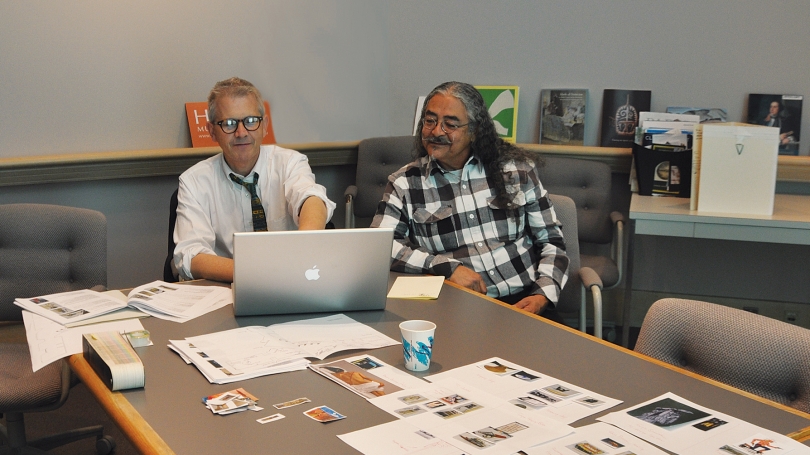Native American Art at Dartmouth surveys for the first time the breadth and depth of the museum's collection of indigenous art of North America, from the historical to the contemporary.
Hood Quarterly, autumn/winter 2011-12
Karen S. Miller, Assistant Curator for Special Projects
The Native American collections are crucial to the museum's mission of teaching with objects, and to presenting the essential continuity within Native American culture between the past and the present.The Hood has holdings that are especially strong in basketry, beadwork, clothing, and examples of the Plains pictorial tradition dating from around 1850 to the early 1900s, as well as works by contemporary Native American artists in a wide range of media, including ceramics, basketry, beadwork, glass, photography, canvas paintings, and mixedmedia assemblages.
This exhibition and its accompanying catalogue celebrate the diversity of these important holdings and testify to the interest in Native cultures by Dartmouth faculty, students, and alumni, museum patrons, and community members. Though it is not encyclopedic, the exhibition is organized by region and includes many of the major art-producing cultures of Native North America:Arctic, Northwest Coast, California/Plateau, Southwest, Plains,Woodlands, and Southeast.
The exhibition's contemporary works, including paintings Fritz Scholder created during his residency at Dartmouth in the fall of 1973 and work by later Native Dartmouth artists-in-residence T. C. Cannon (summer 1975), Allan Houser (spring 1979), and Bob Haozous (summer 1989), showcase the transformation of traditional iconography and use of diverse media in contemporary artistic expression and visual narrative.Accompanied by the very recent work of Dwayne Wilcox, Sierra Teller Ornelas, Nicholas Galanin, and Rebecca Belmore, the contemporary collection also reveals these artists' engagement with issues of Native self-identity as they either build upon or otherwise revisit historical forms of expression in order to subvert stillpotent stereotypes about Native art.
Exhibition guest curators George Horse Capture, Joe Horse Capture, and Joseph Sanchez have each contributed a unique perspective and area of expertise to this exhibition. George Horse Capture and his son Joe are both members of the A'aninin (GrosVentre) tribe from Fort Belknap Indian Reservation in Montana. George is an anthropologist and writer who served as curator of the Plains Indian Museum in Cody, Wyoming (1980– 90), and as consultant to the National Museum of the American Indian inWashington, D.C. (1993–2005). Joe Horse Capture is associate curator of Native American art at the Minneapolis Institute of Arts, where he has organized a number of exhibitions, including From Our Ancestors: Art of the White Clay People in 2010. Joseph Sanchez grew up on the White Mountain Apache reservation in eastern Arizona. He has served as museum deputy director as well as chief curator at the Institute of American Indian Arts (IAIA) in Santa Fe, New Mexico, and as executive director and curator at the Laynor Foundation Museum. In addition to this tripartite curatorial voice, the Hood engaged eight other scholars (and many of the exhibition's contemporary artists) to write essays or prepare statements for the catalogue and the gallery labels.The Native American community at Dartmouth College supplied considerable student and faculty participation in both planning and implementing the exhibition, which boasts a video component that showcases Dartmouth students and alumni discussing their own cultural and artistic experiences.
Fundamentally, this exhibition acknowledges the necessity of recognizing multiple voices and varied interpretations in coming to a fuller understanding of and appreciation for this work as it explores both the continuity and the perpetual evolution of long-held modes and conventions of cultural expression among Native peoples.
This exhibition was organized by the Hood Museum of Art and was generously supported by Mary Alice Kean Raynolds and David R. W. Raynolds, Class of 1949, Susan Ferris, the William B. Jaffe and Evelyn A. Hall Fund, and the Eleanor Smith Fund. A multimedia component was made possible by a gift from Stephen A. Lister, Class of 1963.
Related Exhibitions
- Native American Art at Dartmouth: Highlights from the Hood Museum of Art
- Mateo Romero: The Dartmouth Pow-Wow Suite
- Past exhibitions of Native American art at the Hood
Related Stories
- Fritz Scholder's Dartmouth Portrait #17
- Mateo Romero: The Dartmouth Pow-Wow Suite
- Bob Haozous Residency at Dartmouth College
- Recent Acquisitions: Plains Textile Art
- Recent Acquisitions: Victor Masayesva Jr., Ground Zero, 1998/2007
- Recent Acquisitions: Preston Singletary, Tlingit Crest Hat, 2006
- Recent Acquisitions: Nicholas Galanin, What Have We Become? Vol. 3 & 5a, 2007
